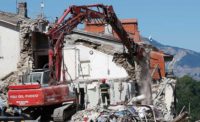Walking through the smashed rubble of the Italian town of Amatrice last week, the Milanese engineer Devis Sonda saw heartrending and familiar sights: limestone boulders spilled into the road, bricks and mortar crushed to powder, heavy concrete ceilings pancaked into floors below, the last desperate days of the Vigil del Fuoco search for remaining trapped survivors in the shadow of rumpled Apennine ridges standing impassively by.
He and his colleagues had seen this before—in L’Aquila in 2009, in Emilia-Romagna in 2012.
The Apennines create some of the most stunning scenes in Italy. Red-tiled medieval villages top steep hillsides reached by narrow winding roads. But even with its Roman heritage, the region is young and (in geologic terms) often in motion. So it was early on August 24 when a magnitude-6.2 earthquake rumbled up from less than three miles below Accumoli, killing nearly 300 in that village, Amatrice and the nearby province of Marche.
As Sonda points out, the town center of L’Aquila—30 miles from Accumoli—has yet to be rebuilt, seven years after it was pulled apart in a devastating quake of its own. Dark reports are surfacing about shoddy construction and criminal elements. As Accumoli and Amatrice now mourn their dead, builders, residents, officials and engineers are looking over the rubble and figuring how to move ahead. The quakes are sure to keep coming.
“We’ve seen completely collapsed buildings, a lot of damage,” Sonda says. He is an engineer for Miyamoto, an international consultancy that for decades has been doing damage reports and providing structural safety expertise in the wake of quakes around the globe. “We’re seeing mostly stone buildings with mud mortar and concrete floors. Very often concrete roofs have replaced regional wooden ones. These performed very badly.” The consequences were deadly.
Reached by phone in Kathmandu, Nepal—where he is advising officials still responding to a quake there from May 2015—consultancy head Kit Miyamoto says the culprits, from a structural and engineering perspective, appear to be buildings made from unreinforced masonry and non-ductile or “brittle,” inflexible concrete structures. These buildings are big problems in a seismic zone, whether they are 600 or six years old. Miyamoto says high casualty counts in earthquakes can very often be traced to these constructions.
Unreinforced masonry in Apennine towns and villages exhibit different levels of soundness and quality, says Guido Magenes, a structural engineering professor at the University of Pavia and researcher at the European Center for Training and Research in Earthquake Engineering. It can range in building walls from low-strength stone that is basically rubble to high-quality dress stone. A potential fatal flaw running through all of it, as in L’Aquila, is that floor, wall and ceiling do not have ties to one another. It’s possible to strengthen them without going into penury, Miyamoto and Magenes say.
When wave after wave of seismic shock ripple through these structures, they are easily untethered and fall. Even reinforced concrete pillars, as civil engineer Gherardo Gotti noted in his Facebook posts, can rotate and lose contact with roof and ceiling, which then collapse. Heavy ceilings have also replaced roofs that were made from wood, sometimes in irregular constructions, Magenes says. He points to full-scale shake-table experiments the earthquake group in Pavia conduct on stone masonry houses with bad floor-to-wall and roof-to-wall connections, in this case with g-force at 0.63. Within seconds, the house is ready to collapse. As Amatrice and Accumoli try to recover, officials are already cataloguing buildings there to see what can be rebuilt and what not. The database will take time to build, but the example of L’Aquila—still in some ways a ghost town—raises questions about what happens after that. The most vivid action that followed L’Aquila was that a prosecutor went after six scientists and a public official for manslaughter. (The convictions were overturned on appeal.)
There are companies that engineer interlocking masonry for seismic-prone areas, such as the Austrian firm Wienerberger’s protherm seismic clay block. For very old towns, though, where the buildings often are built one right next to another, there need to be other solutions than replacing all the bricks. Magenes, who, with his colleagues in Pavia, is considering structural issues all the time, says strengthening techniques don’t have to involve a complete makeover. Short-term retrofitting using perimeter tie rods at floor and roof, or cable bracing under roof pitches, make for low-impact interventions that work—as in this shake-table experiment at g-forces of 1.16—potentially saving lives. Longer-term and more extensive interventions are building and strengthening wall-to-flexible-diaphragm connections or placing steel ring beams at floor level. The houses and villages would still look like Italy.
It’s not just the listed buildings, the old palaces, some of which stand, some of which don’t. “It’s a good question why, sometimes,” Magenes says. Most of the buildings in the region, though, Sonda says, are not historically protected. “But the old ones make villages that are very beautiful places.”
There will be darker days ahead, though. Already questions are being raised about organized-crime involvement in the reconstruction effort, and compromised, corner-cutting, out-of-code buildings that may have made the Amatrice quake all the worse. Magenes recalls an older earthquake, the 2002 Molise quake that collapsed a school building, killing 26 children including all of the fourth grade. There was a great outcry, and new public buildings in particular were to meet high structural standards. As Daily Beast bureau chief Barbie Latza Nadeu points out in her provocative article "How the Mafia Murdered the Townspeople of Amatrice," the primary school in Amatrice collapsed—even after a €700,000 renovation only three years ago. Passions are high, as in L’Aquila when they went after the scientists. It’s too soon to say what happened. But after two devastating quakes in less than a decade, this poor region will feel aftershocks for some time to come.




Post a comment to this article
Report Abusive Comment